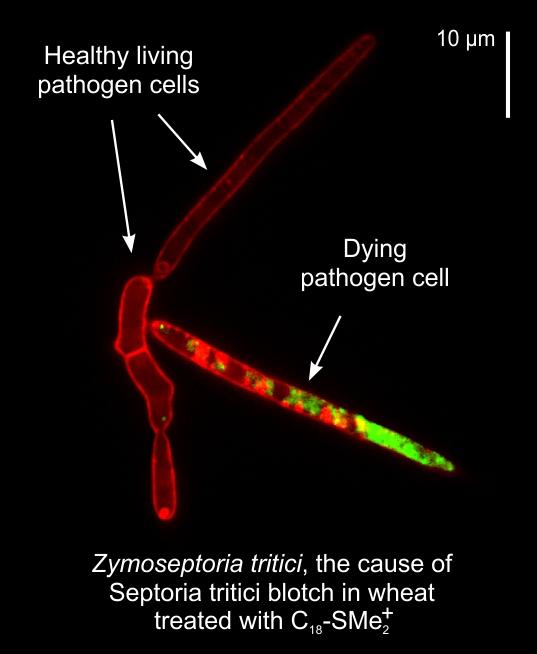Exeter researchers discover a novel chemistry to protect our crops from fungal disease

Zymoseptoria tritici, the cause of Septoria tritici in wheat, treated with C18-SMe2+ Credit: University of Exeter
Currently, we protect our crops against fungal disease by spraying them with anti-fungal chemistries, also known as fungicides.
However, the growing threat of microbial resistance against these chemistries requires continuous development of new fungicides.
A consortium of researchers from the University of Exeter, led by Professor Gero Steinberg, combined their expertise to join the fight against plant pathogenic fungi.
In a recent publication, in the prestigious scientific journal Nature Communications, they report the identification of novel mono-alkyl chain lipophilic cations (MALCs) in protecting crops against Septoria tritici blotch in wheat and rice blast disease.
These diseases challenge temperate-grown wheat and rice, respectively, and so jeopardise the security of our two most important calorie crops.
The scientists' journey started with the discovery that MALCs inhibit the activity of fungal mitochondria.
Mitochondria are the cellular “power-house”, required to provide the “fuel” for all essential processes in the pathogen.
By inhibiting an essential pathway in mitochondria, MALCs cut down the cellular energy supply, which eventually kills the pathogen.
Whilst Steinberg and colleagues show that this “mode of action” is common to the various MALCs tested, and effective against plant pathogenic fungi, one MALC that they synthesised and named C18-SMe2+ showed unexpected additional modes of action.
Firstly, C18-SMe2+ generates aggressive molecules inside the mitochondria, which target life-essential fungal proteins, and in turn initiate a “self-destruction” programme, which ultimately results in “cellular suicide” of the fungus.
Secondly, when applied to crop plants, C18-SMe2+ “alerts” the plant defence system, which prepares the crop for subsequent attack, thereby increasing the armoury of the plant against the intruder.
Most importantly, the Exeter researchers demonstrate that C18-SMe2+ shows no toxicity to plants and is less toxic to aquatic organisms and human cells than existing fungicides sprayed used in the field today.
Professor Steinberg said: “It is the combined approach of Exeter scientists, providing skills in fungal cell biology (myself, Dr Martin Schuster), fungal plant pathology (Professor Sarah J. Gurr), human cell biology (Professor Michael Schrader) and synthetic chemistry (Dr Mark Wood) that enabled us to develop and characterise this potent chemistry.
“The University has filed a patent (GB 1904744.8), in recognition of the potential of this novel chemistry in our perpetual fight against fungi.
“We now seek partners/investors to take this development to the field and prove its usefulness under 'real agricultural conditions'. Our long-term aim is to foster greater food security, in particular in developing nations.”
Professor Steinberg added: “I always wanted to apply my research outside of the ivory tower of academia and combine the fundamental aspects of my work with a useful application.
“The visionary approach of the Biological Sciences Research Council (BBSRC) provided me with this opportunity, for which I am very grateful. In my mind, this project is a strong example of translational research that benefits the public.”
Professor Sarah Gurr said: “This is such a timely and important study. We are increasingly aware of the growing burden of plant disease caused by fungi and of our need to safe-guard our calorie and commodity crops better.
“The challenge is not only to discover and describe the mode of action of new antifungals but to ensure that chemistries potent against fungi do not harm plants, wildlife or human health.
“This new antifungal is thus an exciting discovery and its usefulness may extend beyond crops into the realms of fungal disease in humans and, indeed to various applications in the paint and preservative industries. This merits investment!”
###
The study was funded by the Biotechnology and Biological Sciences Research Council (BBSRC).
The paper, published in the Journal Nature Communications, is entitled: “A lipophilic cation protects crops against fungal pathogens by multiple modes of action”, authored by G. Steinberg, M. Schuster, S.J. Gurr, T. Schrader, M. Schrader, M. Wood, A. Early and S. Kilaru.
Media Contact
More Information:
http://dx.doi.org/10.1038/s41467-020-14949-yAll latest news from the category: Agricultural and Forestry Science
Newest articles

NASA: Mystery of life’s handedness deepens
The mystery of why life uses molecules with specific orientations has deepened with a NASA-funded discovery that RNA — a key molecule thought to have potentially held the instructions for…

What are the effects of historic lithium mining on water quality?
Study reveals low levels of common contaminants but high levels of other elements in waters associated with an abandoned lithium mine. Lithium ore and mining waste from a historic lithium…

Quantum-inspired design boosts efficiency of heat-to-electricity conversion
Rice engineers take unconventional route to improving thermophotovoltaic systems. Researchers at Rice University have found a new way to improve a key element of thermophotovoltaic (TPV) systems, which convert heat…



